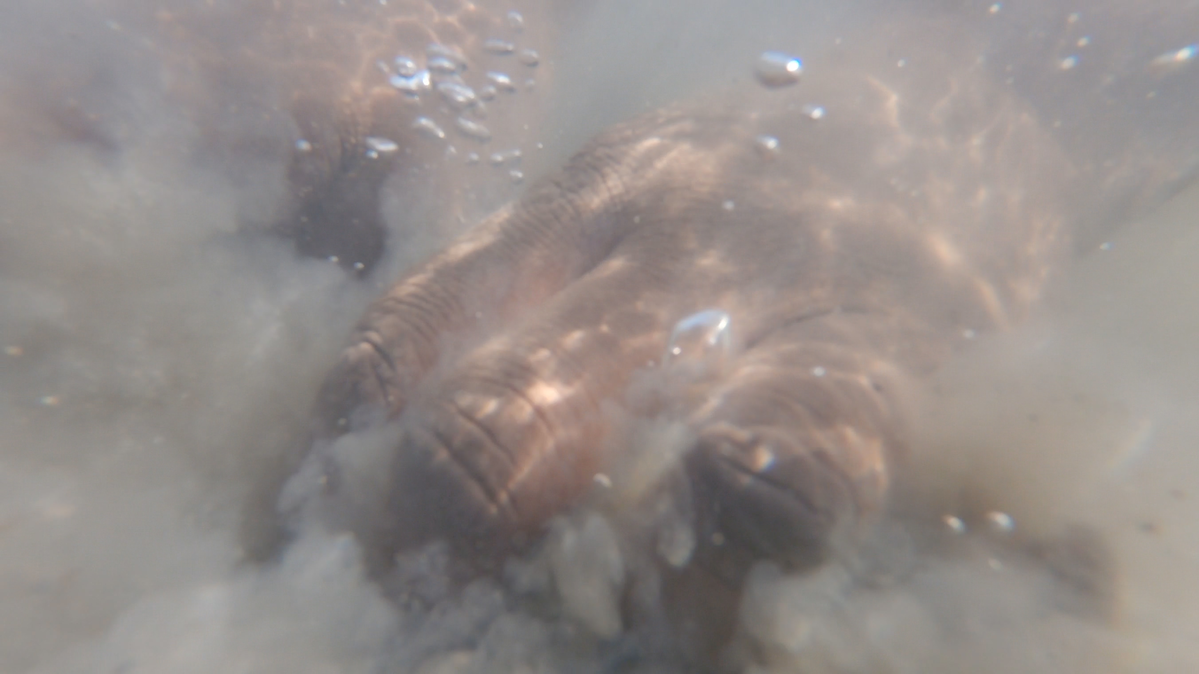Gleaning, Sound, and Haptics
The sound of gushing water and the hard shells of molluscs rubbing and banging against plastic sieves and buckets echoed across the mudflat. Quieter were the sounds of crunching, bubbling water, fragments of conversations, singing, and individual calls, all transported by the wind along the surface of the water, slowly receding with the falling tide. The mudflat would soon lay bare.
I stood with Aissatou in the knee-deep water and filmed her gleaning for cockles, the type of molluscs most frequently sought after in the Sine-Saloum Delta. Her practice was routinized and competent. An experienced gleaner, Aissatou worked with great continuity and efficiency. Yet, she was also attuned to other actors and the larger environment and its sensory aspects – the moving water, the wind, the ground, the molluscs, and the other gleaners. She repeatedly talked and joked with the latter across the distance while barely looking their way. Gleaning as an amphibious, multisensory practice is thus about directing one’s attention while at the same time maintaining a broad awareness, balancing habitualized skill and exposure (see Simon 2021, 2022). Gleaners follow lives and lifelines, not disentangling them but incorporating them into their own (see Tsing 2015).
Gleaners mostly work at their own pace and at some distance from each other. When the water is still covering the sandbank or mudflat, they use their fingers and hands to detect living molluscs (and leave the dead, sharper ones be), draw them towards themselves and scoop them together with mud into sieves. Their movements underwater bring little sound to the surface. But if the tide is low enough and the sieve not fully submerged, dropping the mud into it makes a loud splashing sound. Gleaners repeat this work sequence until the sieves are full. To separate molluscs, soil, and water, they then shake the sieves back and forth vigorously, submerging one side and keeping the other in the air and emitting loud sounds of gushing water and rubbing and banging molluscs. Consequently, they sort out some dead shells, which makes a crunching sound, before throwing the remaining living molluscs into buckets with a loud crunching and banging sound. When these buckets are full, gleaners empty them into rice bags that figure as temporary storage, emitting a deeper crunching sound.
This pattern of work sequences results in a swelling and ebbing of connected sounds. The sieving and the transfer into the buckets create the loudest sounds that – together with the sounds of the other work sequences as well as voices, wind, and water, the periodic call of the muezzins or passing motorboats or planes – reverberate across space. The work sequence where gleaners move their fingers and hands underwater through the mud, in contrast, contributes little to this soundscape. In these moments, where gleaners register their own practice primarily haptically, the larger soundscape, including the sounds of the other gleaners, moves more to the auditive foreground. This, in turn, opens a space for a more etic alignment with or re-confirmation of the doing and location of others. Individual gleaners thus both contribute and orient themselves to a soundscape that emerges through the interplay of human and more-than-human movement and activity. Along these lines of relations, sound guides the gleaners’ work rhythms and is a marker for (shared) competence (van den Berg 2022). Together with the cyclical receding and advancing water of the tides, sounds also inform gleaners’ positionalities, and how they move individually and collectively during the day; it is thus an ecological sound that encompasses both surroundability and directionality (Ihde [1976] 2007), also in an acousmatic way when what causes the sound is not seen. For competent gleaners, sound is informative and meaningful, and they might in certain circumstances rely on hearing rather than listening (cf. Förster 2001): Aissatou and others, while cockle gleaning, do not need to listen to (or observe) the ebbing tide in a focused manner for it to be sensually effective in co-guiding their movements; they hear, see, and feel the receding water.
In their practice, gleaners’ bodies oscillate between solid and liquid, wet and dry, once more sunken into the mud and surrounded by water, and once more buffeted by air. Their feet, knees, or bottoms remain connected to the ground, while their ears remain above the watery surface, even when their doings shift underwater. Sound that remains underwater, traveling through the water and the ground, remains beyond the grasp of their hearing and can only be felt haptically. To inquire into it further and bring it to our ears, we are dependent on “transducing – that is, converting, transmuting – sound from the medium of water into that of air” (Helmreich 2007: 622). This requires artifacts, artifacts that ultimately afford both an extension of and disconnection from our ethnographic selves, reconfigure our senses and offer us new mobilities, knowledge, and power (Keating 2005; Grasseni and Gieser 2019; Black 2017).

